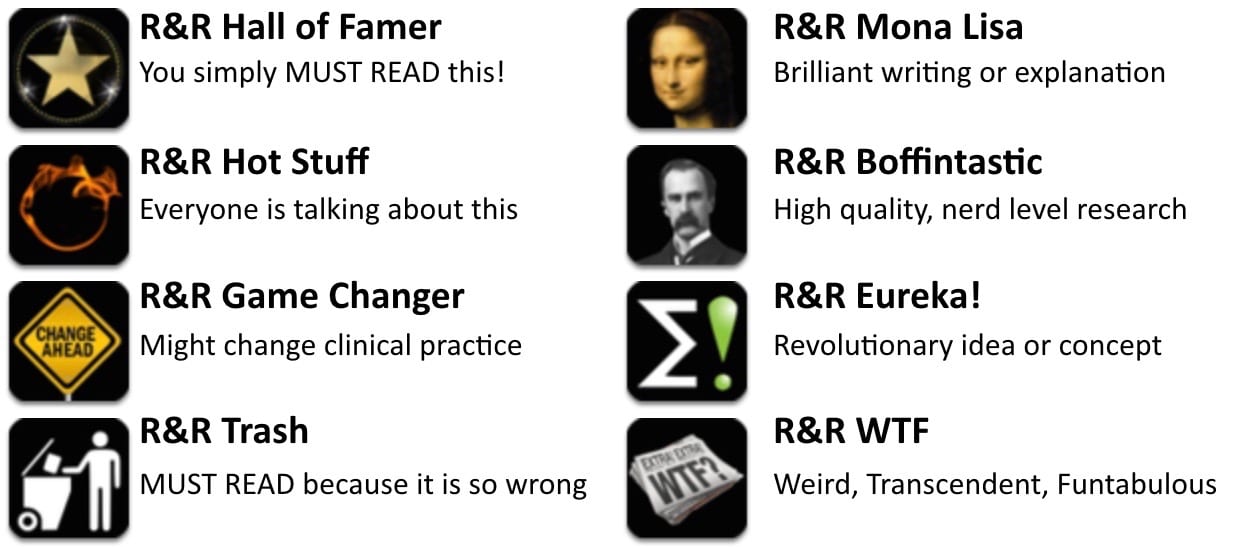R&R In The FASTLANE 084
Welcome to the 84th edition of Research and Reviews in the Fastlane. R&R in the Fastlane is a free resource that harnesses the power of social media to allow some of the best and brightest emergency medicine and critical care clinicians from all over the world tell us what they think is worth reading from the published literature.
This edition contains 6 recommended reads. The R&R Editorial Team includes Jeremy Fried, Nudrat Rashid, Soren Rudolph, Anand Swaminathan and, of course, Chris Nickson. Find more R&R in the Fastlane reviews in the : Overview; Archives and Contributors
This Edition’s R&R Hall of Famer
Perkins GD et al. Mechanical versus manual chest compression for out-of-hospital cardiac arrest (PARAMEDIC): a pragmatic, cluster randomised controlled trial. Lancet 2015; 385(9972): 947-55. PMID: 25467566
- In this british trial prehospital use of mechanical chest compression (LUCAS-2 device) vs manual chest compression was studied. The primary outcome was survival to 30 days after the cardiac arrest event. During the study period 4471 patients was assigned to the study group (1652 ptts) or control group (2819 ptts). Only 60% (985) of patients actually received mechanical chest compression in the study group, and <1% (11) of patients in the control group received mechanical compressions.In the intention-to-treat analysis, 30 day survival was similar between the two groups – 6% vs 7%; adjusted odds ratio [OR] 0·86, 95% CI 0·64–1·15).Together with the LINC trial the PARAMEDIC study provides evidence that mechanical chest compressions does not provide improvements in survival after OHCA and widespread routine use is not warranted. Still mechanical chest compression devices may be of benefit in special circumstances as a bridge to more advanced therapies like ECMO supported PCI in selected patients.
- Recommended by: Søren Rudolph
Chan KE et al. Dabigatran and Rivaroxaban Use in Atrial Fibrillation Patients on Hemodialysis. Circulation 2015. PMID: 25595139
- The use of novel anticoagulants (NOAC), such as Dabigatran and Rivaroxaban, is contraindicated in patients with reduced renal function. This papers examines the use and outcomes of NOACs in patients on dialysis. Not surprisingly the risk of bleeding, hospitalization and death are very high. The risk of hemorrhagic death is 71-78% higher compared to Warfarin. The bottom line is pretty simple, they are contraindicated and are clearly associated to death. Stop doing it!
- Recommended by: Daniel Cabrera
Hoskote SS et al. Simulation-based Training for Emergency Medicine Residents in Sterile Technique During Central Venous Catheterization: Impact on Performance, Policy, and Outcomes. Acad Emerg Med 20152(1):81-7. PMID: 25556399
- Reducing catheter related bloodstream infections (CRBIs) is an important initiative. Anecdotally, Emergency Department placed lines are thought to be inherently “dirty” as they are often placed in emergent situations where rapid access is essential. This leads to their removal later in the ICU with replacement under more sterile conditions. This study demonstrated that using a simulation program, EM residents could be brought up to speed on proper sterile technique and that these lessons could be applied clinically. The authors of this study found identical CRBI rates between ED and MICU placed central lines after this educational intervention.
- Recommended by: Anand Swaminathan
Hildebrand DR et al. Modern management of splenic trauma. BMJ. 2014; 348. PMID: 24696170
- Pediatric patients with abdominal trauma can be a challenge to assess. Naturally, we often are concerned for potential splenic injury. What is the most current approach to managing splenic injury? Find out.
- Recommended by: Sean Fox
Chang YH et al. Cyanoacrolate glue ingestion with formation of a laryngeal cast. Resuscitation 2011; 82(5): 507. PMID: 21324579
- I know we all love airway models but don’t try this at home: very cool yet extremely scary case report of a superglue ingestion causing a nice but occlusive airway cast.
- Recommended by: Seth Trueger
Berger FH et al. Body packing: a review of general background, clinical and imaging aspects. Radiol Med 2015; 120(1): 118-32. PMID: 25300715
- This is a lovely paper with huge numbers of great images on how to image the body packer. (short answer, probably CT without oral contrast, quelle surprise…). There’s also some interesting images of money concealed in remarkable orifices…
- Recommended by: Andy Neill
- Read More: Best Paper Yet on Screening Suspected Body Packers (The Poison Review)
Intensivist and Donation Medical Specialist, Australia | @NudratRashid |








